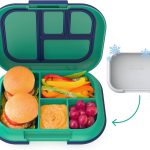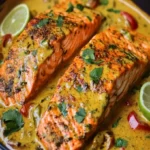Description
Welcome to our delightful kitchen, where we bring you the exotic and rich flavors of the Caribbean with this Caribbean-Style Coconut Curry Salmon recipe! If you’re a fan of bold, tropical dishes or love experimenting with new flavors, this recipe is perfect for you. Get ready to whip up a quick and satisfying meal that combines tender salmon with a creamy, spicy coconut curry sauce that will make your taste buds dance.
Ingredients
- 4 salmon fillets, about 5–6 ounces each, skin-off
- Kosher salt & freshly ground black pepper, to taste
- 1 tablespoon + 2 teaspoons Caribbean-style curry powder, divided (adjust for desired heat level)
- 1 teaspoon garlic powder
- 1/2 teaspoon smoked paprika
- 3 tablespoons olive oil, divided
- 2 tablespoons unsalted butter
- 1 red bell pepper, thinly sliced
- 1 green bell pepper, thinly sliced
- 1 small white onion, thinly sliced into half-moons
- 6 cloves of garlic, finely minced or pressed
- 1 teaspoon fresh grated ginger
- 6 sprigs fresh thyme, de-stemmed
- 1/2 teaspoon ground Jamaican allspice
- 1 (14 ounce/400ml) can full-fat coconut milk
- 1 scotch bonnet pepper, left whole- optional for extra heat
Optional Substitutions:
- Replace coconut milk with almond or soy milk for a lighter version.
- Use tofu or chickpeas instead of salmon for a vegetarian twist.
Instructions
Step 1: Prep & Season
Start by patting the salmon fillets dry with a paper towel. In a small bowl, mix together the salt, pepper, 2 teaspoons of curry powder, garlic powder, and smoked paprika. Drizzle 1 tablespoon of olive oil over the salmon, then rub the spice blend evenly over each fillet. Set aside to marinate for about 5 minutes.
Step 2: Sear the Salmon
In a large nonstick skillet, heat 1 tablespoon of olive oil over medium-high heat. Once the oil is hot and shimmering, place the seasoned salmon fillets in the skillet. Sear the salmon, undisturbed, for 2-3 minutes until a deep, golden-brown crust forms. Flip the fillets and cook for another 1-2 minutes until they reach your desired doneness. Remove the salmon from the skillet and set it aside on a clean plate.
Step 3: Burn the Curry
Lower the heat to medium and add the remaining olive oil to the pan. Sprinkle in the remaining curry powder and stir frequently for about 30 seconds, until the curry becomes fragrant and takes on a rich golden-brown color.
Step 4: Sauté the Aromatics & Add Spices
Add the butter, sliced bell peppers, and onion into the skillet. Sauté for about 3-4 minutes until softened. Next, add the minced garlic, grated ginger, fresh thyme, and Jamaican allspice. Stir until everything is well combined and fragrant, about 1-2 minutes.
Step 5: Add Coconut Milk & Simmer Sauce
Pour in the coconut milk and add the whole scotch bonnet pepper (if using). Bring the mixture to a gentle simmer, stirring occasionally. Taste and season with more salt and pepper if needed. Add the seared salmon fillets back into the skillet, spooning some sauce over each piece. Simmer for another 1-2 minutes to allow the flavors to meld.
Step 6: Serve & Enjoy
Discard the scotch bonnet pepper before serving. Spoon the creamy curry sauce generously over each fillet and serve the salmon with a side of steamed jasmine rice or sautéed veggies. Enjoy the explosion of Caribbean flavors!
Equipment

2Pcs Heart Shape Cake Pans, Aluminum Heart Cake Mold, Reusable 10 inch
Buy Now →
Kids Chill Leak-Proof Lunch Box – Included Reusable Ice Pack Keeps Food Cold
Buy Now →Notes
- Don’t Overcook the Salmon: The key to perfect salmon is to avoid overcooking. Cook until the salmon is just opaque and flakes easily.
- Use Full-Fat Coconut Milk: For a richer and creamier sauce, opt for full-fat coconut milk instead of light versions.
- Handle Scotch Bonnet Pepper with Care: If using the scotch bonnet, keep it whole and avoid cutting it to control the heat level.
